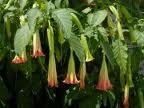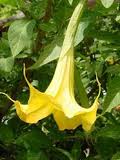Toé is the name given in the Upper Amazon to various species of Brugmansia, primarily B. suaveolens and a wide variety of cultivars. Poet César Calvo calls toé “that other powerful and disconcerting hallucinogen.” Toé contains the primary tropane alkaloids hyoscyamine, atropine, and scopolamine; it may be mixed into the ayahuasca drink, ingested in the form of raw plant materials, or smoked in a cachimbo pipe. Toé is considered one of the most powerful plants, a strong but dangerous ally. Toé, mapacho, and ayahuasca — scopolamine, nicotine, and dimethyltryptamine — are the three primary psychoactive plants of the Upper Amazon. This psychoactive triad provides, respectively, power, protection, and teaching.
 |
Some researchers maintain that all the forms of toé in the Amazon are cultivars. Ethnobotanist Wade Davis points out that the grotesque forms of many of these cultivars, generally called borrachero in Colombia, “are caused by viral infections. The Indians note that the varieties breed true and that each has quite specific pharmacological properties that can be manipulated by the shaman.” These borrachero cultivars are given distinct names — munchiro borrachero, culebra borrachero. Indeed, according to ethnobotanists Richard Schultes and Robert Raffauf, Methysticodendron amesianum, a small tree containing high concentrations of scopolamine, may not be a distinct genus at all, but rather a highly atrophied form of toé — the result of a viral infection or mutation recognized and cultivated for its psychoactive effects.
The intoxication induced by scopolamine and the other tropane alkaloids can last as long as four days, with often terrifying paranoid visions, followed by a calmer state, and then retrograde amnesia, total or partial. Scopolamine overdose is recognized as a cause of acute paranoid hallucinatory psychoses, of a state of delirium like that associated with a very high fever, and of acute toxic psychosis, including confusion, agitation, rambling speech, hallucinations, paranoid behaviors, and delusions. The hallucinations induced by scopolamine are, as a general rule, terrifying.
Brugmansia species, with their large and dramatic flowers, bright colors, and noticeable evening scent, are, under the name angel’s trumpet, very popular decorative plants in North America. An overdose of scopolamine can be fatal. Self-experimentation is profoundly unwise.
 |
Ethnobotanist Wade Davis has described the experience of toé as “a wild, crazed state, total disorientation, delirium, foaming at the mouth, a wicked thirst, terrifying visions that fuse into a dreamless sleep, followed by complete amnesia.” Richard Schultes and Robert Raffauf describe it as “a loss of senses, visual disturbances, drying of the throat and mouth, visions (sometimes of a frightening character) and occasionally violent reactions requiring restraint.” Don Agustin Rivas describes his first experience with toé like this: “Five minutes after I drank toé, my body started to jerk all over, with my arms twitching and jerking…. My head ached, and I began to see demons, colors, strange men, animals, and aggressive snakes that wanted to bite me. I tried to remain still but it was impossible.”
One highland shaman told anthropologist Michael Taussig that, when one drinks toé, one races around screaming, ripping off clothes, urinating all over the place, robbing things, without realizing what one is doing, like in a dream. “It’s really awful,” the shaman said, “not like yagé. It’s as if your clothes come off. Your throat becomes dry, dry … and then this passes and you forget.” The flower, he said, is “sweet like honey, but strong! Thus! Boom! Crash to the floor. Remember nothing. Nothing.”
The Shuar call the plant maikua, and drink the raw juice of the green bark of the stem. Anthropologist Michael Harner reports that they consider maikua to be the most dangerous and powerful hallucinogen. The effects begin within three or four minutes; the drinker is accompanied by an adult, for restraint if necessary when the drinker becomes delirious and tries to run off into the jungle. The vision can consist of two gigantic animals — often jaguars or boas — fighting each other, or a disembodied human head, or a ball of fire. When the vision gets near, the drinker must be brave enough to run forward and touch it, whereupon it instantly explodes and disappears.
The visions given by toé are dark and frightening. Animals and humans that might in an ayahuasca vision appear to be potential allies appear in a toé vision to be menacing or terrifying. That is why toé grants such power: it demands great courage; if you can survive the toé vision, the spirit world holds few terrors. Thus, too, toé hardens the body, makes it a cuerpo cerrado or cuerpo sellado, a body that is closed or sealed, resistant to attack by sorcerers. In the Amazon, as elsewhere, courage creates power.

- Previous Post: Extraordinary Anthropological Experiences
- Next Post: Norval Morrisseau (1931-2007)
- More Articles Related to: Plant Medicine, Sacred Plants, Shamanism, The Amazon



Amigo Steve, have you tried the Toe, what was it like?
I’ve actually tried it. I was with my Shaman, Genji in what I call his “Entheogen Garden”. Some of the plants there I have never seen and can’t get him to tell me, but
the day I tried it I used it without his consent. He was fearful that I would hurt myself. So I gathered up three petals trying to convince him that it was OK. He had a frown on his face and look worried, and tried to stop me but to no prevail. I quickly light up his fire pit and put a stainless steel pot of boiled sea water from the nearby beach and boiled the petals quickly until a brown tea. As genji sat, his face looked worried and I put the fire out and gathered a cupful of the liquid and drunk it gleefully. After 20 or so minutes of feeling quite sick, I threw up in front of me, then my body just sat there, not moving, in a dumbfound state. I slowly looked around me, and my vomit turned blue like the ocean. Then, eyes and a mouth just floated up and startevd talking to me. The background was waving like the sea, too. Suddenly, Genji jumped as I slowly looked towards him as he shouted my name in fear. I remember him running quickly into his garden, he came bac with some herbs I couldn’t identify, biled tthemin fear and as he ran over to me he tilted my head back and fed my the herbal concoction of plants and I instantly went out of my delirious state. But I still found myself seeing things. I was shaken and the plant Guardian angered by the interruption of my initiation into power, we both got a bad deal with her (Whom the guardian of Genji’s datura was a Dragon) and now I have to redo the ritual and Genji, knowing of her fearful power pleaded for forgiveness. She has forgave him but would like to repeat the ritual, although my shaman Geniji is still afraid of performing it, I have matured now and he’s taking it into consideration.Srry if I spelt anything wrong, tablets really aren’t made for typing.